The focus here is on learning the really common birds which you can expect to see on the coastline in the Western Cape. These are the species you are most likely to encounter on the beach, or along a section of rocky shore.
GULLS: Perhaps the birds which first come to mind when you say “seashore” are the gulls. 99.9% of the gulls of the Western Cape are either Hartlaub’s Gulls or Kelp Gulls. Adults are easy to tell apart. Kelp Gulls are much bigger than Hartlaub’s Gulls. When they are sitting, Kelp Gulls have black backs, and Hartlaub’s Gulls have grey backs.
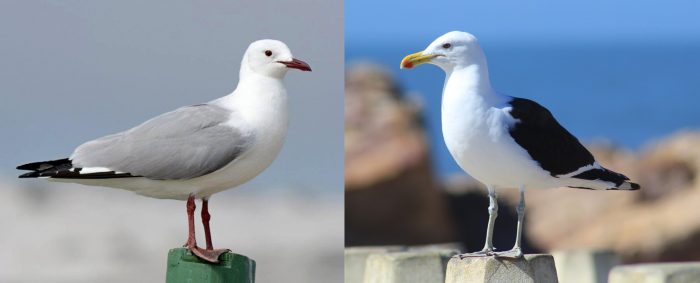
The Hartlaub’s Gull is on the left, and the Kelp Gull on the right. It would be nice if it were that simple. You need to go the blog posts for each species to discover the complications caused by the age of the bird, i.e. the juvenile plumages. This is true for all the species presented here.
CORMORANTS: Next up are the cormorants (duikers in Afrikaans). There are four species, but one of these (the Bank Cormorant) is so rare that it is classified as Critically Endangered. That leaves three feasible species: White-breasted Cormorant (left), Cape Cormorant (middle) and Crowned Cormorant (right):
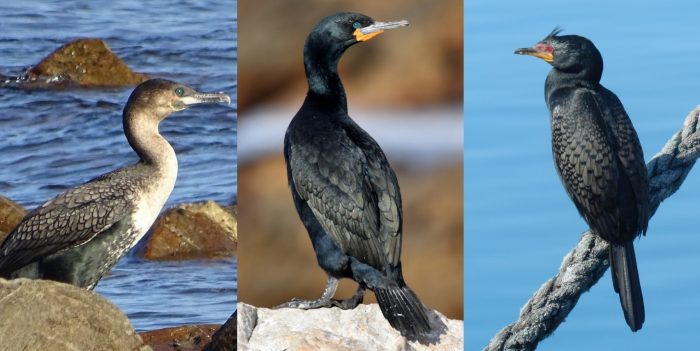
These three birds are dry, so you can see the intricate patterning of the feathers of their folded wings. When they are wet, they look black. The White-breasted Cormorant on the left is the largest, and has a blue eye. But so does the Cape Cormorant in the middle. The Crowned Cormorant on the right has a red eye. The Cape Cormorant has a notably short tail; the Crowned Cormorant has a long tail. If you see the crest feathers sticking up or you see the red eye, then it can only be Crowned Cormorant. The White-breasted Cormorant has a patch of yellow skin at the base of the bill. The other two species have orange, but in different patterns. These three cormorants are not that simple to distinguish. This is especially true when you add young birds into the mix. You need to look at the full texts for each species.
TERNS: Not every piece of shoreline has terns. Where they occur, they are often in large flocks. The tern species in the Western Cape all have grey wings, the same shade of grey as Hartlaub’s Gull. Essentially the terns look like sporty versions of the gulls. The terns are sleek and aerodynamic compared to the gulls. Most of the terns on the shoreline of the Western Cape belong to one of three species: Swift Tern (yellow bill), Sandwich Tern (black bill tipped yellow) and Common Tern (plain back bill). In reality it is not that simple. When you encounter a flock of terns, it may consist of one, or two or all three of these species. Often the flock of terns might have merged with a flock of gulls.

Except for rare vagrants, the Swift Tern is the only tern in the Western Cape with a yellow bill. The yellow-tipped black bill is globally unique to the Sandwich Tern (although there are a few species with black-tipped yellow bills). The legs and head of the Common Tern can vary between red and black, and all shades in-between. For all the species the head pattern is variable; it is not a useful identification feature. Size is useful. The photo below shows the Common Tern above in context:

The Common Tern is much smaller than the Swift Tern. The strange bird on the right is a young Swift Tern. The Sandwich Tern is intermediate in size between Common Tern and Swift Tern. Size is only useful if you are looking at a flock of terns.
OYSTERCATCHER: A plump black bird with a red dagger for a bill is African Oystercatcher.
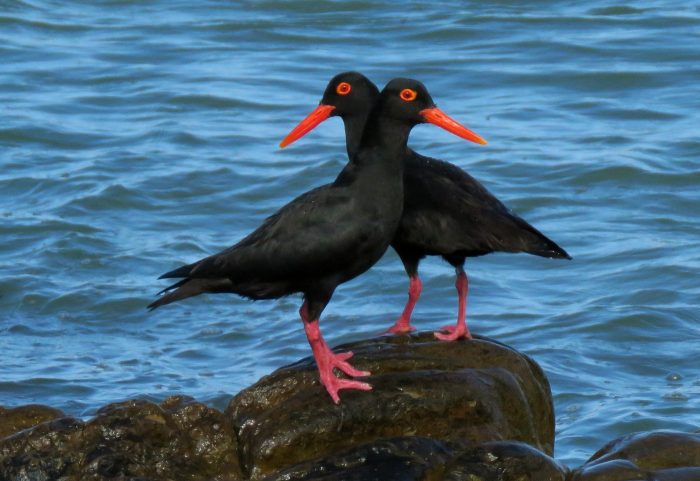
Oystercatchers breed during summer, when they have to share the shore with holiday makers. If you are angling or picnicking on the shore, and a pair of oystercatchers is persistently making a lot of noise, they are trying to communicate with you: “Please move along a 50 m or so; we are not comfortable having you so close to our nest.”
EGRET: A white bird with blackish legs which looks like it walked through spilt paint and got yellow feet is Little Egret. They are most conspicuous on the shore at low tide, when they feed in the rock pools.

There are other species in this family, the egrets and the herons, which are quite often on the coastline; Little Egret is the one that is most frequently encountered. Grey Heron comes second. Apart from the cormorants, these are the only birds on the shore that you would really consider taking a photograph of in portrait, rather than landscape, mode. They are all much taller than they are wide!
DUCKS & GEESE: One “duck-type” bird has added the coastline to its set of preferred habitats: Egyptian Goose:

If this blog had been written two decades ago, the Egyptian Goose would not have featured. Traditionally, they are birds of freshwater. Somehow, they discovered that the green sea lettuce (scientific name Ulva) was edible. (In the photo above for the Little Egret, the bird is hiding its right foot in sea lettuce.)
IBISES: There are two ibises on the shore. The noisy Hadeda Ibis (brown) and the silent African Sacred Ibis (white with black head).

Ibises have a uniquely distinctive shape. African Sacred Ibis on left; Hadeda Ibis on right
SMALL BIRDS – WAGTAIL, STARLING, WADERS : As soon as you get into the vegetation behind the coastline, whether it is natural, alien or gardens, there are a lot of bird species which you can encounter. But there are only five small species that you are likely to encounter on the beach or in the rock pools of the inter-tidal zone: Cape Wagtail (grey and white with black bib), Common Starling (black), White-fronted Plover (mostly white and cream), Ruddy Turnstone (black, white and brown) and Sanderling (white and grey).
Cape Wagtails (left) and Common Starlings (right) are two landbirds that feed in the intertidal zone right down to the edge of the sea:
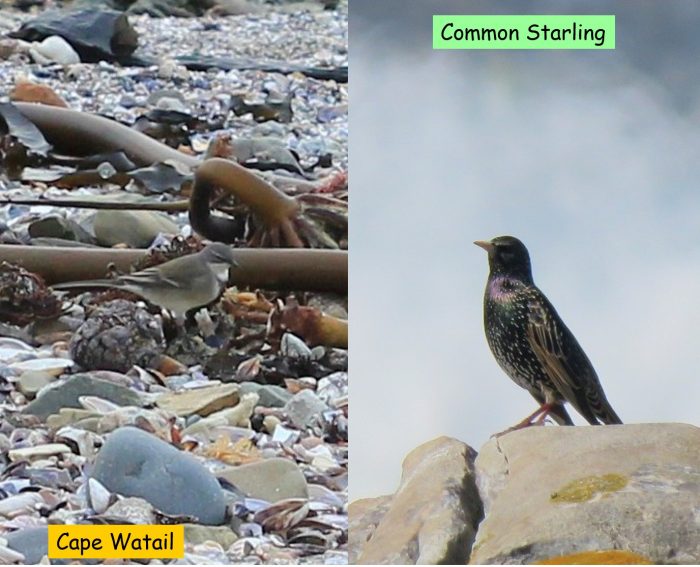
Sanderlings (left) are mostly found on sheltered sandy beaches, feeding at the edge of the waves, running at speed to keep pace with the waves. White-fronted Plovers (centre) occur on both sandy and rocky shores, feeding from the edge of the sea to the back of the beach. Ruddy Turnstones (right) are mostly on rocky shores, or feeding on piles of kelp washed up on sandy shores.
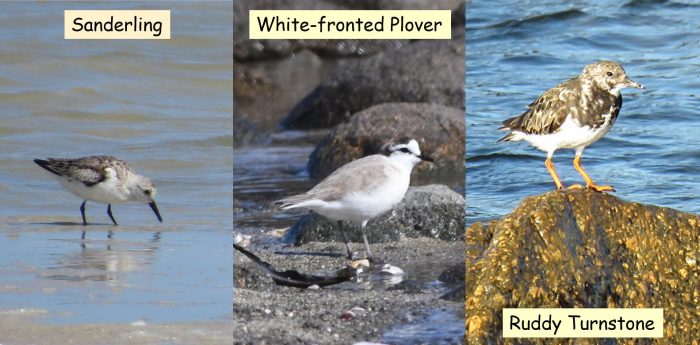
Sanderlings and Ruddy Turnstones breed in Siberia, and migrate to the Western Cape for the local summer (about September to April). White-fronted Plovers are residents, and breed on the shore just above the high tide level.
Of course, there are lots of other species of birds on the coastline. For example, if you go to the Boulders or Stony Point, you will certainly see African Penguins. If you visit Bird Island at Lambert’s Bay, you will see Cape Gannets in their thousands.
If you manage to take a photograph of any bird listed above, please submit it to the Virtual Museum. You can include your own identification, even if it is a bit tentative. The expert panel will confirm whether you have got it right. If you see a bird which is not listed above, do try to take a photograph and submit it to the Virtual Museum. You can leave the species field blank, and a member of the expert panel will do the identification. Every record is valuable as evidence that a species still occurs at a locality.
Recommended citation format: Underhill LG 2021. Birds on the coastline of the Western Cape. Biodiversity and Development Institute. Available online at http://thebdi.org/2021/06/11/birds-on-the-coastline-of-the-western-cape/

